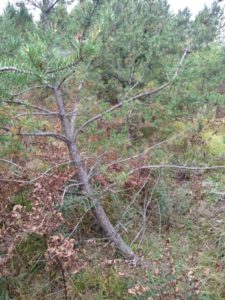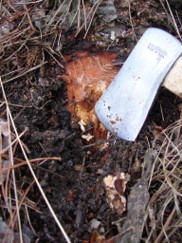By Linda Williams, forest health specialist, Woodruff. Linda.Williams@wisconsin.gov; 920-360-0665

This jack pine is leaning due to damage at its base from pine root collar weevil. Photo: Linda Williams
Damage from pine root collar weevils was recently reported in Lincoln, Marinette, and Vilas counties on jack pine trees. Pine root collar weevils are known to attack and kill all types of pines, although scotch, red, and jack pine are the most common hosts in Wisconsin. The insects attack pine trees of varying sizes – from large saplings to those of small pole size. Adult weevils deposit eggs at the tree’s base; larvae then bore under bark and feed in the root collar area, effectively girdling the tree. Soil and bark near the root collar becomes blackened and soaked with pitch. Feeding larvae are visible in tunnels under the bark.

Look for blackened, pitch-soaked soil at the base of trees when you suspect the presence of pine root collar weevils. White larvae are visible under bark. Photo: Linda Williams
Adult beetles prefer dark, cool, moist conditions such as those found in tall grass or in the deep duff layer around the base of a tree. Substantial impacts on trees are seen after only a few attacks; trees may lean or tip and turn off-color. Severe damage can cause mortality.
To limit problems caused by pine root collar weevil:
• Avoid planting trees too deeply;
• Prune lower branches and/or control grass competition to increase air flow;
• Rake away duff from the base of the tree to create a drier and warmer root collar area (usually this needs to be done only once);
• Do not plant red and jack pine within one mile of infested Scotch pine stands;
• Avoid mulching around these trees because mulch creates dark, cool, humid environments, and;
• Use an insecticide to kill adult weevils in the soil and root collar area (always follow label directions).
